TOYOTA CAMRY V20 1986 Service Information
Manufacturer: TOYOTA, Model Year: 1986, Model line: CAMRY V20, Model: TOYOTA CAMRY V20 1986Pages: 2389, PDF Size: 84.44 MB
Page 461 of 2389
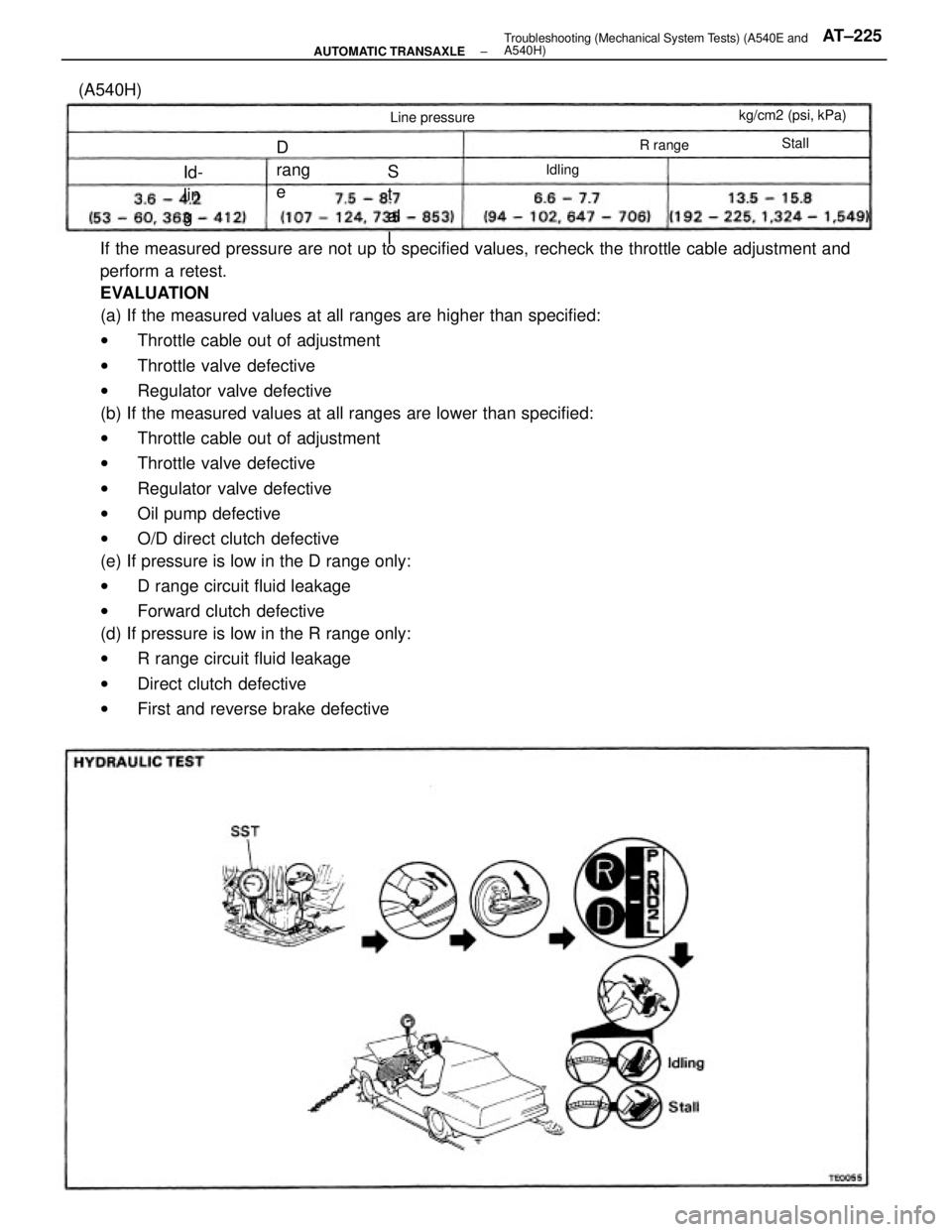
If the measured pressure are not up to specified values, recheck the throttle cable adjustment and
perform a retest.
EVALUATION
(a) If the measured values at all ranges are higher than specified:
wThrottle cable out of adjustment
wThrottle valve defective
wRegulator valve defective
(b) If the measured values at all ranges are lower than specified:
wThrottle cable out of adjustment
wThrottle valve defective
wRegulator valve defective
wOil pump defective
wO/D direct clutch defective
(e) If pressure is low in the D range only:
wD range circuit fluid leakage
wForward clutch defective
(d) If pressure is low in the R range only:
wR range circuit fluid leakage
wDirect clutch defective
wFirst and reverse brake defective
kg/cm2 (psi, kPa)
Line pressure
(A540H)
R rangeD
rang
e Id-
lin
g
IdlingS
t
al
l
Stall
± AUTOMATIC TRANSAXLETroubleshooting (Mechanical System Tests) (A540E and
A540H)AT±225
Page 462 of 2389
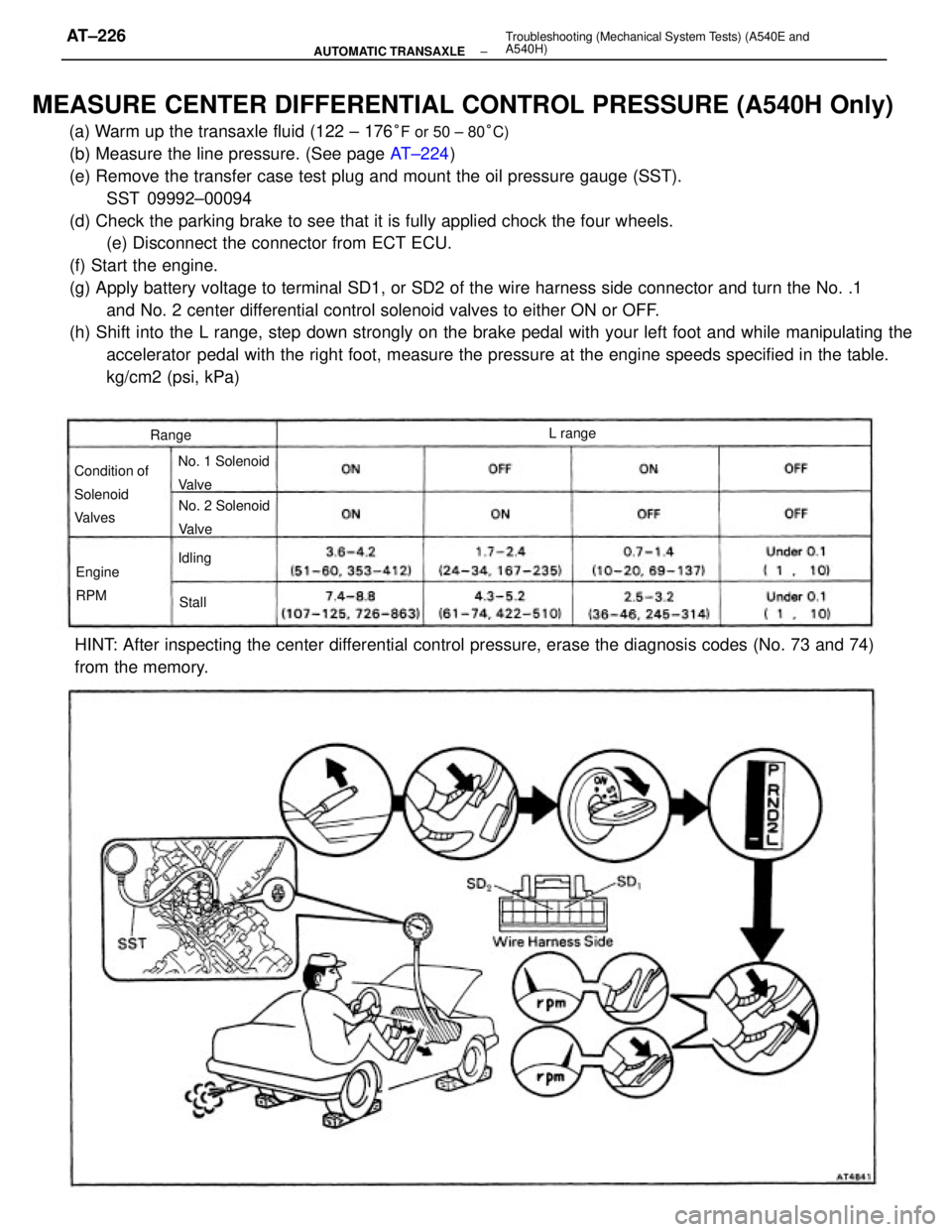
MEASURE CENTER DIFFERENTIAL CONTROL PRESSURE (A540H Only)
(a) Warm up the transaxle fluid (122 ± 176°F or 50 ± 80°C)
(b) Measure the line pressure. (See page AT±224)
(e) Remove the transfer case test plug and mount the oil pressure gauge (SST).
SST 09992±00094
(d) Check the parking brake to see that it is fully applied chock the four wheels.
(e) Disconnect the connector from ECT ECU.
(f) Start the engine.
(g) Apply battery voltage to terminal SD1, or SD2 of the wire harness side connector and turn the No. .1
and No. 2 center differential control solenoid valves to either ON or OFF.
(h) Shift into the L range, step down strongly on the brake pedal with your left foot and while manipulating the
accelerator pedal with the right foot, measure the pressure at the engine speeds specified in the table.
kg/cm2 (psi, kPa)
HINT: After inspecting the center differential control pressure, erase the diagnosis codes (No. 73 and 74)
from the memory.
Condition of
Solenoid
ValvesNo. 1 Solenoid
Valve
No. 2 Solenoid
Valve
Engine
RPML range
Range
Idling
Stall
± AUTOMATIC TRANSAXLETroubleshooting (Mechanical System Tests) (A540E and
A540H)AT±226
Page 463 of 2389
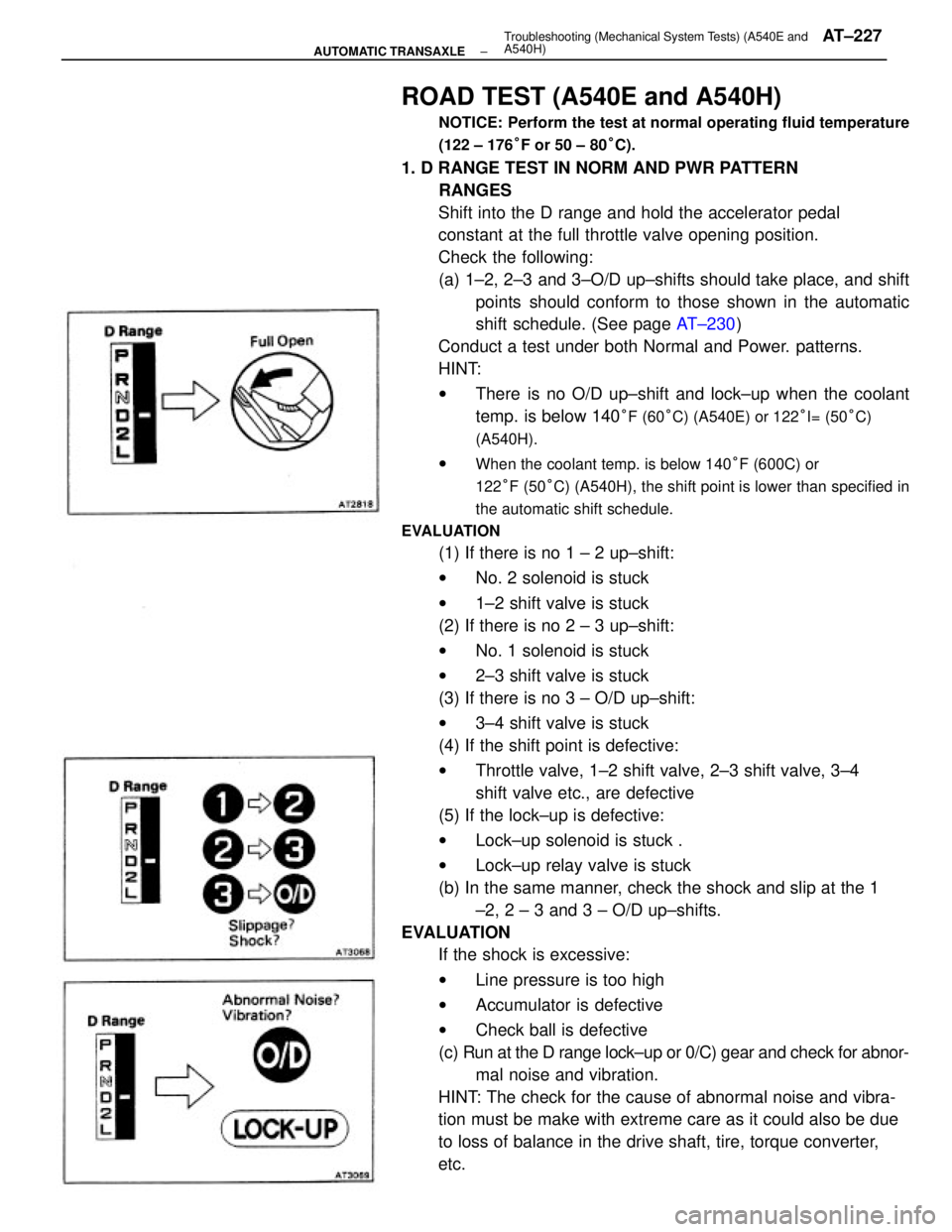
ROAD TEST (A540E and A540H)
NOTICE: Perform the test at normal operating fluid temperature
(122 ± 176°F or 50 ± 80°C).
1. D RANGE TEST IN NORM AND PWR PATTERN
RANGES
Shift into the D range and hold the accelerator pedal
constant at the full throttle valve opening position.
Check the following:
(a) 1±2, 2±3 and 3±O/D up±shifts should take place, and shift
points should conform to those shown in the automatic
shift schedule. (See page AT±230)
Conduct a test under both Normal and Power. patterns.
HINT:
wThere is no O/D up±shift and lock±up when the coolant
temp. is below 140
°F (60°C) (A540E) or 122°I= (50°C)
(A540H).
wWhen the coolant temp. is below 140°F (600C) or
122°F (50°C) (A540H), the shift point is lower than specified in
the automatic shift schedule.
EVALUATION
(1) If there is no 1 ± 2 up±shift:
wNo. 2 solenoid is stuck
w1±2 shift valve is stuck
(2) If there is no 2 ± 3 up±shift:
wNo. 1 solenoid is stuck
w2±3 shift valve is stuck
(3) If there is no 3 ± O/D up±shift:
w3±4 shift valve is stuck
(4) If the shift point is defective:
wThrottle valve, 1±2 shift valve, 2±3 shift valve, 3±4
shift valve etc., are defective
(5) If the lock±up is defective:
wLock±up solenoid is stuck .
wLock±up relay valve is stuck
(b) In the same manner, check the shock and slip at the 1
±2, 2 ± 3 and 3 ± O/D up±shifts.
EVALUATION
If the shock is excessive:
wLine pressure is too high
wAccumulator is defective
wCheck ball is defective
(c) Run at the D range lock±up or 0/C) gear and check for abnor-
mal noise and vibration.
HINT: The check for the cause of abnormal noise and vibra-
tion must be make with extreme care as it could also be due
to loss of balance in the drive shaft, tire, torque converter,
etc.
± AUTOMATIC TRANSAXLETroubleshooting (Mechanical System Tests) (A540E and
A540H)AT±227
Page 464 of 2389
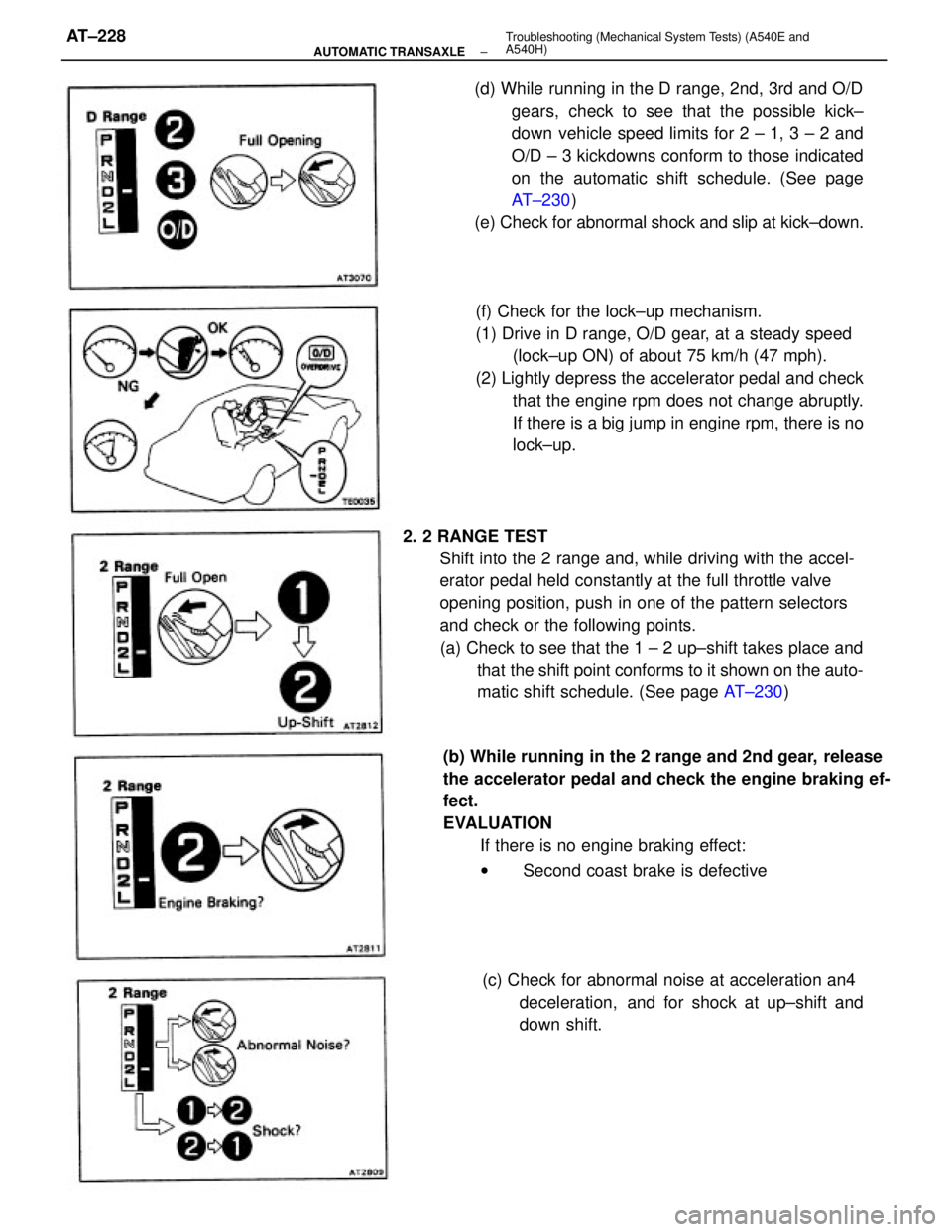
2. 2 RANGE TEST
Shift into the 2 range and, while driving with the accel-
erator pedal held constantly at the full throttle valve
opening position, push in one of the pattern selectors
and check or the following points.
(a) Check to see that the 1 ± 2 up±shift takes place and
that the shift point conforms to it shown on the auto-
matic shift schedule. (See page AT±230)
(b) While running in the 2 range and 2nd gear, release
the accelerator pedal and check the engine braking ef-
fect.
EVALUATION
If there is no engine braking effect:
w Second coast brake is defective (f) Check for the lock±up mechanism.
(1) Drive in D range, O/D gear, at a steady speed
(lock±up ON) of about 75 km/h (47 mph).
(2) Lightly depress the accelerator pedal and check
that the engine rpm does not change abruptly.
If there is a big jump in engine rpm, there is no
lock±up. (d) While running in the D range, 2nd, 3rd and O/D
gears, check to see that the possible kick±
down vehicle speed limits for 2 ± 1, 3 ± 2 and
O/D ± 3 kickdowns conform to those indicated
on the automatic shift schedule. (See page
AT±230)
(e) Check for abnormal shock and slip at kick±down.
(c) Check for abnormal noise at acceleration an4
deceleration, and for shock at up±shift and
down shift.
± AUTOMATIC TRANSAXLETroubleshooting (Mechanical System Tests) (A540E and
A540H)AT±228
Page 465 of 2389
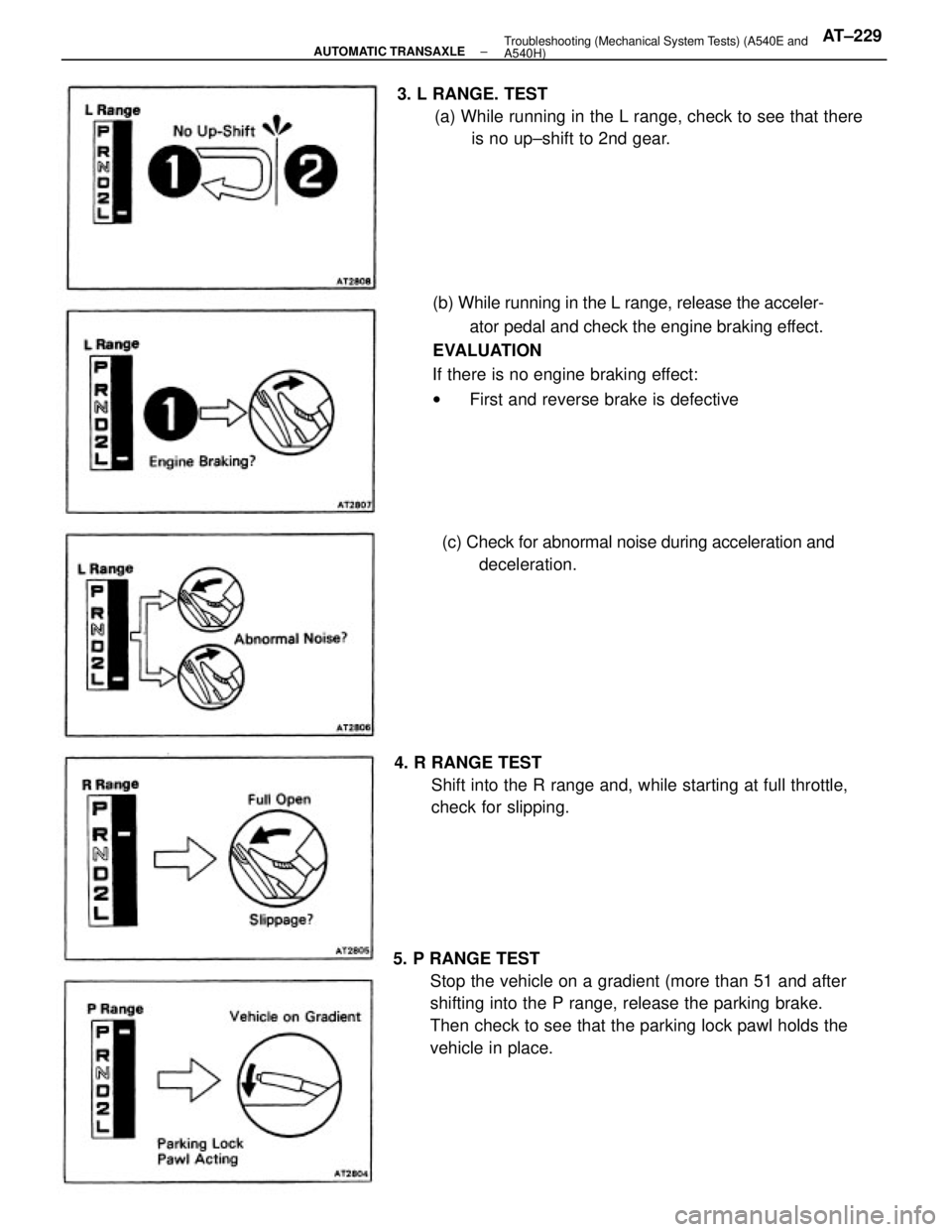
5. P RANGE TEST
Stop the vehicle on a gradient (more than 51 and after
shifting into the P range, release the parking brake.
Then check to see that the parking lock pawl holds the
vehicle in place.(b) While running in the L range, release the acceler-
ator pedal and check the engine braking effect.
EVALUATION
If there is no engine braking effect:
wFirst and reverse brake is defective 3. L RANGE. TEST
(a) While running in the L range, check to see that there
is no up±shift to 2nd gear.
4. R RANGE TEST
Shift into the R range and, while starting at full throttle,
check for slipping.(c) Check for abnormal noise during acceleration and
deceleration.
± AUTOMATIC TRANSAXLETroubleshooting (Mechanical System Tests) (A540E and
A540H)AT±229
Page 466 of 2389
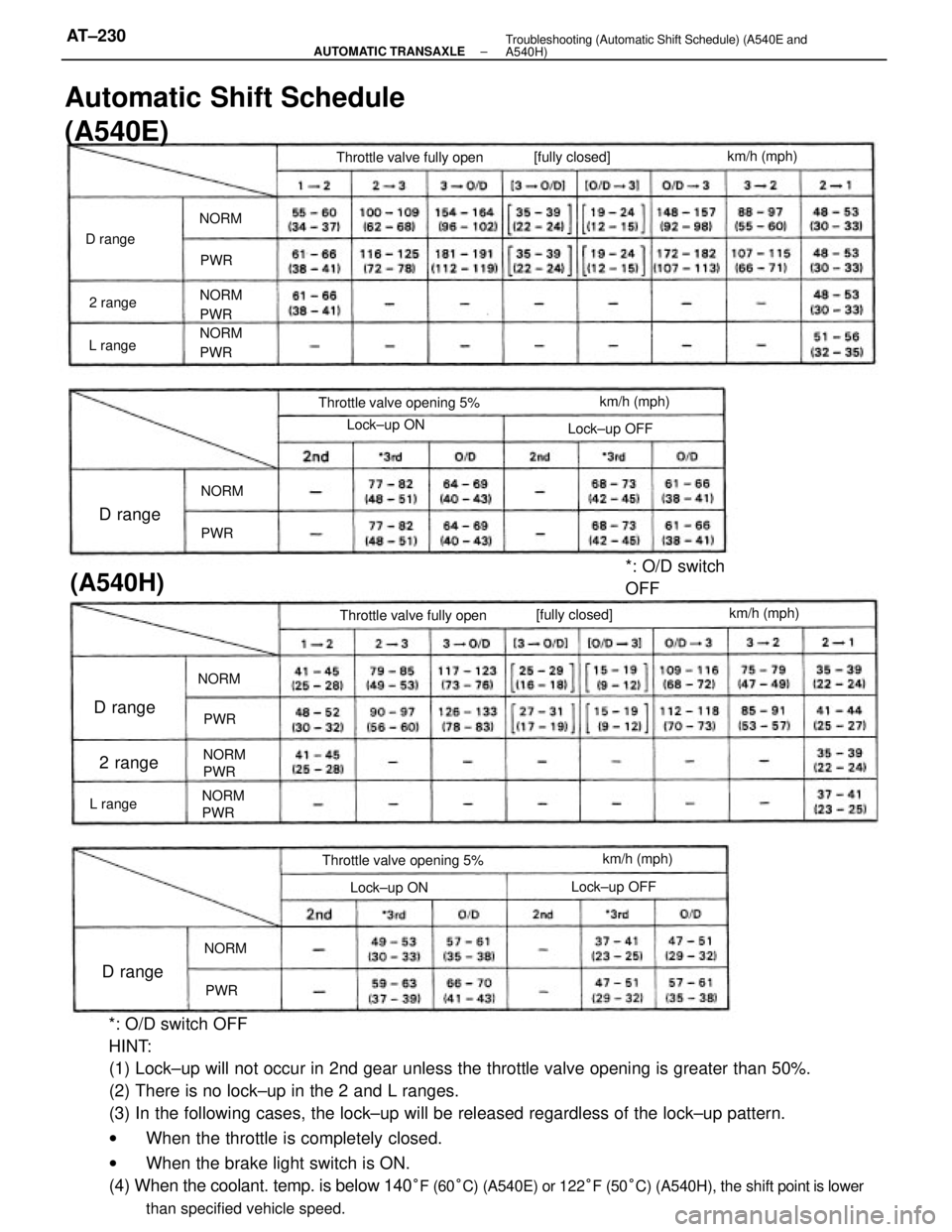
*: O/D switch OFF
HINT:
(1) Lock±up will not occur in 2nd gear unless the throttle valve opening is greater than 50%.
(2) There is no lock±up in the 2 and L ranges.
(3) In the following cases, the lock±up will be released regardless of the lock±up pattern.
wWhen the throttle is completely closed.
wWhen the brake light switch is ON.
(4) When the coolant. temp. is below 140
°F (60°C) (A540E) or 122°F (50°C) (A540H), the shift point is lower
than specified vehicle speed.
Automatic Shift Schedule
(A540E)
Throttle valve opening 5%
Throttle valve opening 5%Throttle valve fully open
Throttle valve fully open
*: O/D switch
OFF
(A540H)
Lock±up ON[fully closed]
Lock±up OFFkm/h (mph) Lock±up OFFkm/h (mph)
[fully closed]
km/h (mph)
Lock±up ONkm/h (mph) NORM
PWR NORM
PWR
NORM
PWRNORM
PWR
D range D range
D range
2 range
D range
2 range
L range
L rangeNORM
NORM NORM
NORM
PWR PWR PWR
PWR
± AUTOMATIC TRANSAXLETroubleshooting (Automatic Shift Schedule) (A540E and
A540H)AT±230
Page 467 of 2389
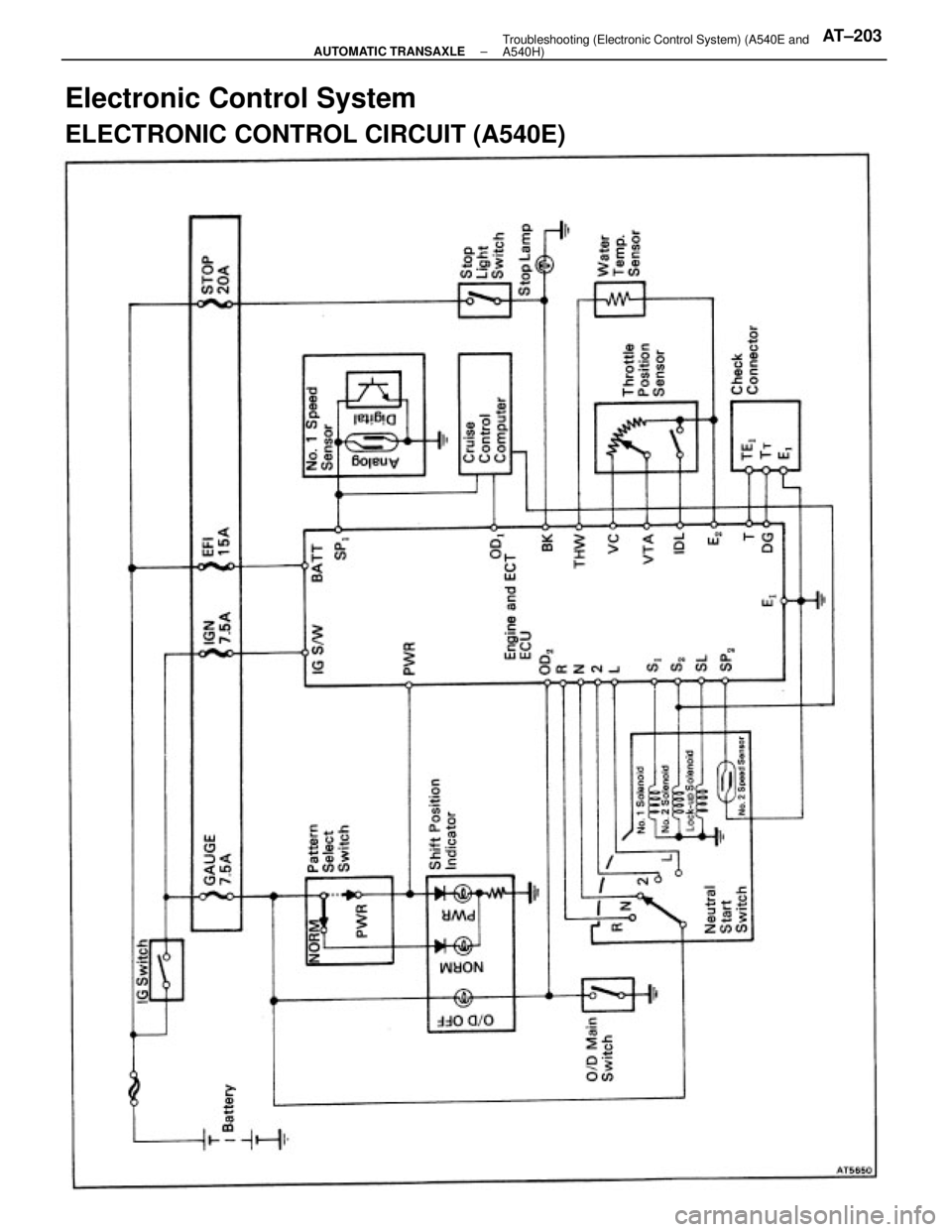
Electronic Control System
ELECTRONIC CONTROL CIRCUIT (A540E)
± AUTOMATIC TRANSAXLETroubleshooting (Electronic Control System) (A540E and
A540H)AT±203
Page 468 of 2389
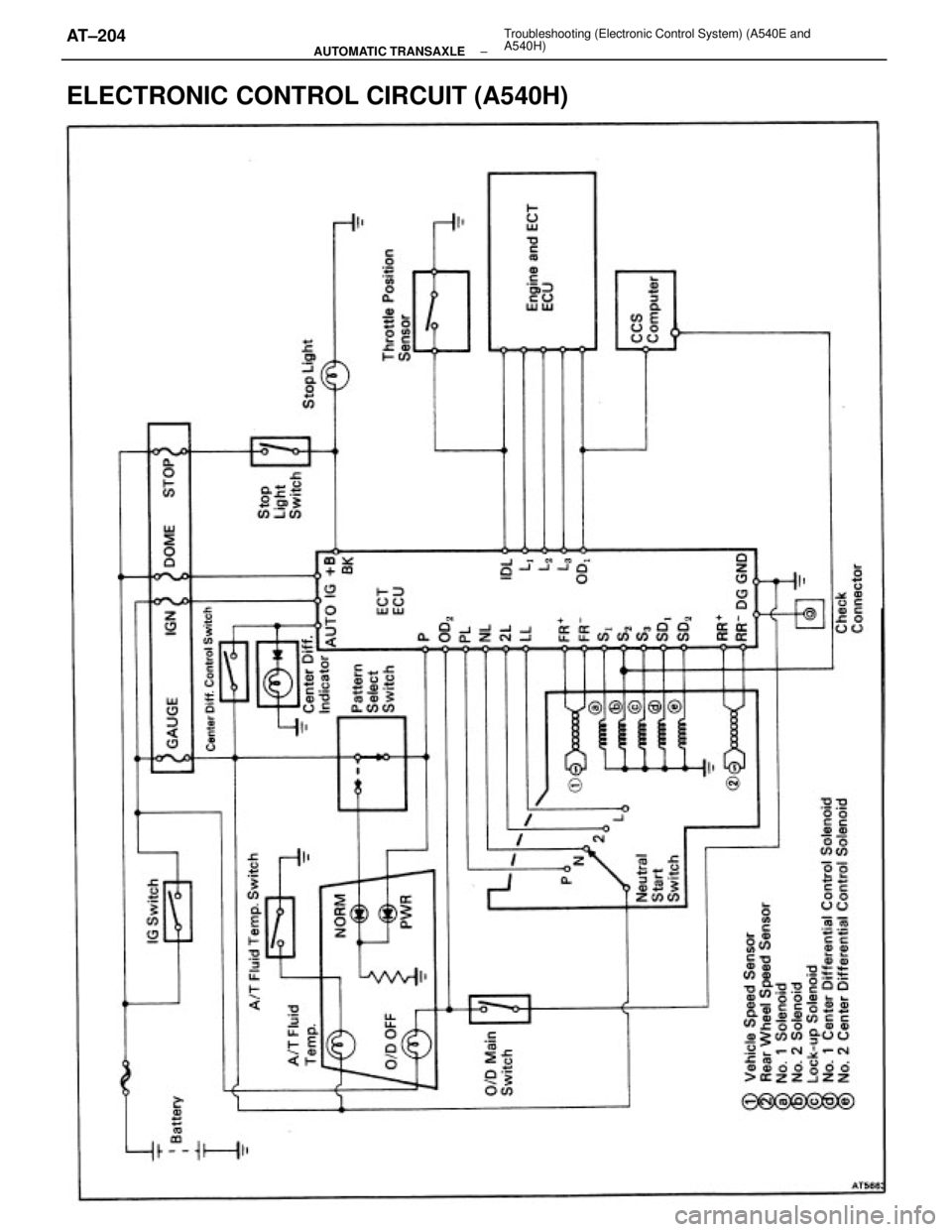
ELECTRONIC CONTROL CIRCUIT (A540H)
± AUTOMATIC TRANSAXLETroubleshooting (Electronic Control System) (A540E and
A540H)AT±204
Page 469 of 2389
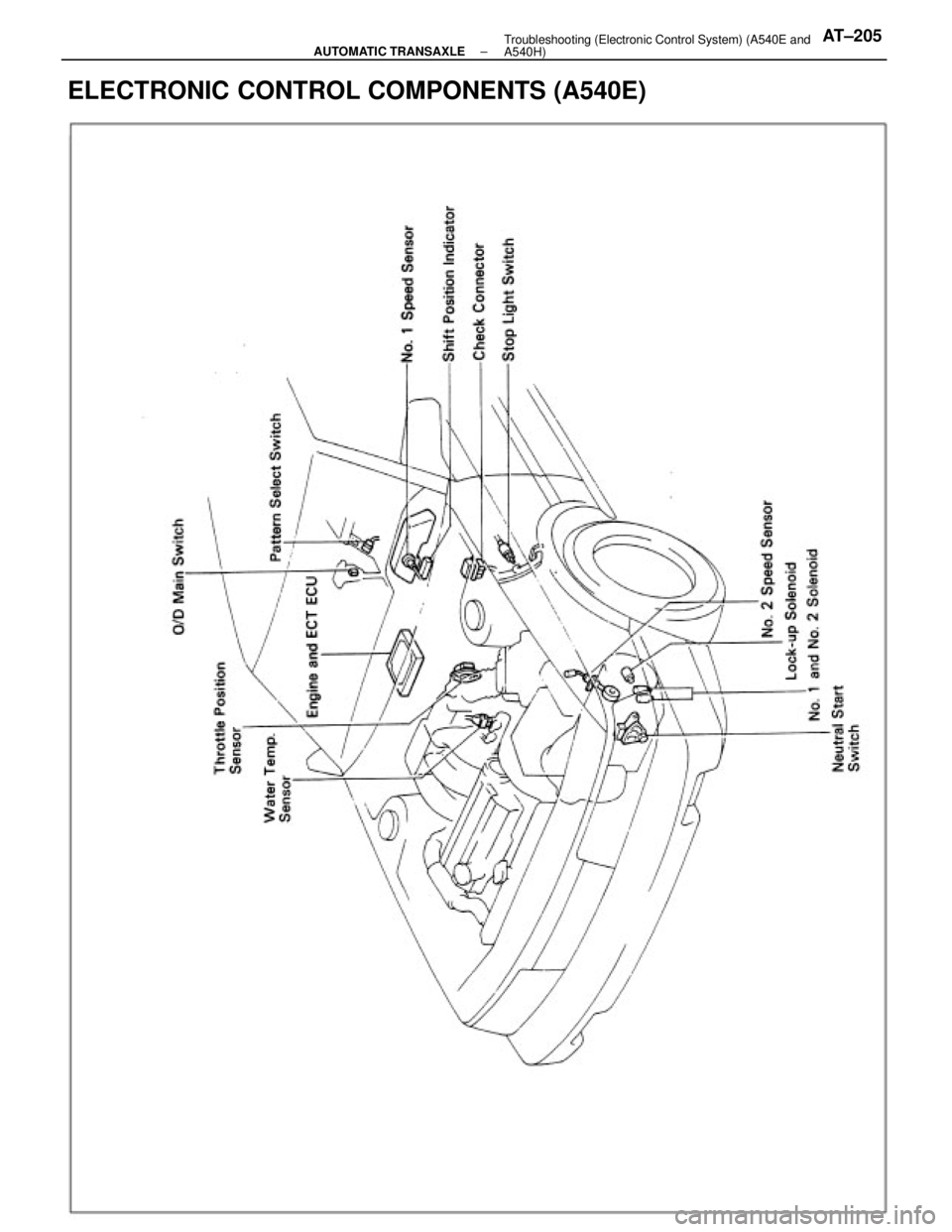
ELECTRONIC CONTROL COMPONENTS (A540E)
± AUTOMATIC TRANSAXLETroubleshooting (Electronic Control System) (A540E and
A540H)AT±205
Page 470 of 2389
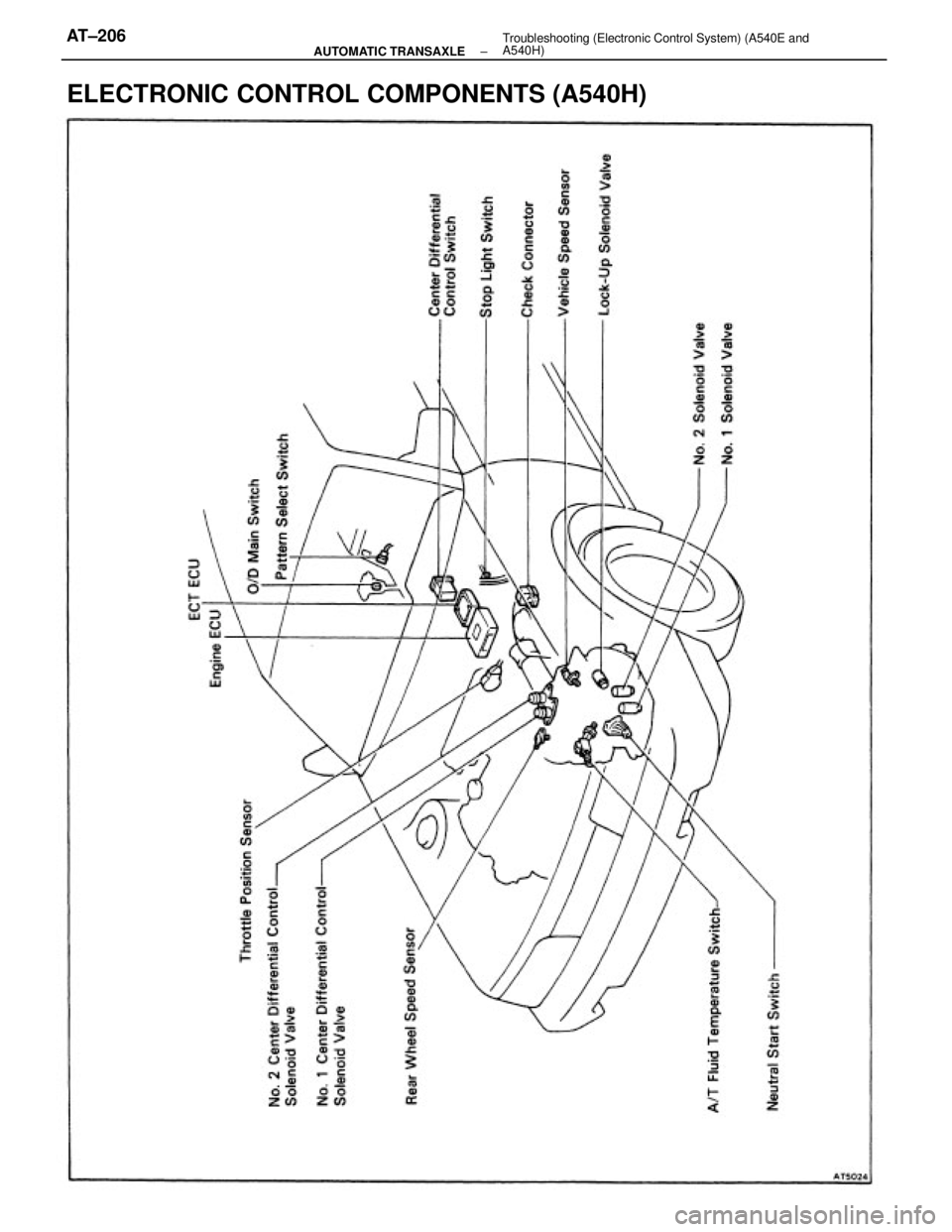
ELECTRONIC CONTROL COMPONENTS (A540H)
± AUTOMATIC TRANSAXLETroubleshooting (Electronic Control System) (A540E and
A540H)AT±206